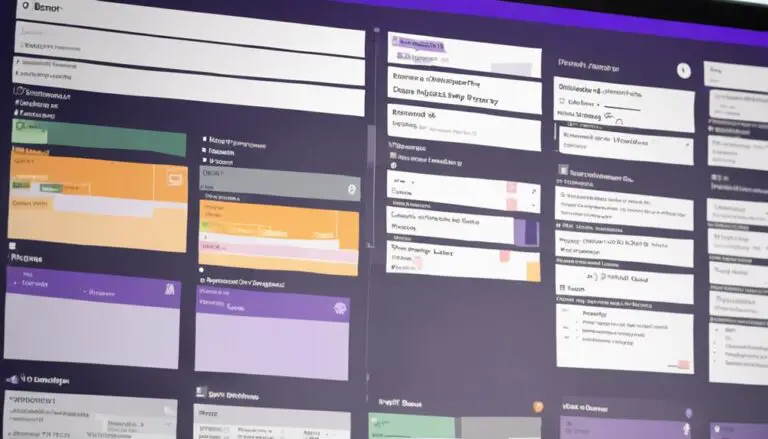When aiming to enhance operational effectiveness and streamline workflow in project management, consider incorporating sprints within your Kanban system. This strategic approach, often underestimated, can significantly boost productivity and task management.
By intertwining sprints seamlessly into your Kanban process, you'll unlock a powerful method that not only accelerates progress but also fosters a culture of continuous improvement.
Stay tuned to discover how this harmonious blend can revolutionize your team's efficiency and project outcomes.
Key Takeaways
- Combine sprints with Kanban to enhance planning and delivery processes.
- Incorporate time-limited iterations in Kanban workflow for incremental goals.
- Use sprint planning techniques to streamline workflow efficiency and adapt to changing priorities.
- Enhance team productivity by setting clear goals, fostering collaboration, and improving predictability.
Benefits of Combining Sprints With Kanban
By incorporating sprints into your Kanban workflow, you can effectively introduce structured time-boxed iterations that enhance planning and delivery processes. This integration allows the product owner and Scrum master to work together closely, ensuring that the team collaborates seamlessly. The flow of work becomes more visible as the team visualizes workflow through Kanban boards, promoting increased efficiency and smoother transitions between tasks.
With sprints in Kanban, the team gains a clearer understanding of priorities, thanks to the structured iterations that focus on delivering incremental value. The Scrum master plays a crucial role in facilitating these sprints, ensuring that the work must align with the team's goals and the overall project vision. Through this collaborative approach, team members can adapt to changing priorities while maintaining a steady workflow, ultimately optimizing the flow efficiency and productivity of the entire team.
This shared cadence fosters a sense of belonging and purpose within the team, driving them towards achieving their goals together.
Implementing Sprints in Kanban Workflow
To enhance your Kanban workflow with sprints, consider implementing time-limited iterations for task completion. By incorporating sprints in Kanban, you introduce a structured approach to managing tasks within a specific timeframe.
These time-limited iterations, known as sprints, enable your team to focus on achieving incremental goals, leading to more predictable delivery and increased productivity. With sprints in Kanban, you can enhance team collaboration by providing a clear direction and fostering a sense of achievement as tasks are completed within each sprint.
This structured approach not only improves task prioritization but also boosts overall workflow efficiency. Embracing sprints in your Kanban workflow allows you to maintain the flexibility and visual nature of Kanban while adding the benefit of time-boxed work periods.
Sprint Planning Techniques in Kanban
Let's explore essential points related to sprint planning in Kanban, focusing on tips for determining sprint duration and strategies for effectively allocating team capacity.
These factors play a crucial role in streamlining workflow efficiency and ensuring that the team can deliver value incrementally. By understanding these key elements, teams can adapt and refine their sprint planning techniques to meet changing priorities and improve overall productivity.
Sprint Duration Tips
For optimal sprint planning techniques in Kanban, consider the varying durations that can be tailored to your team's preferences and project requirements. When determining sprint durations, keep in mind the flexibility available in Kanban to adjust based on capacity and task complexity.
Here are some tips to help you optimize your sprint duration:
- Experiment with different sprint lengths to find what works best for your team.
- Shorter sprints, like 1 week, can provide quick feedback loops.
- Longer sprints, up to 4 weeks, may allow for more substantial work completion.
- Align sprint durations with your team's preferences and project needs.
- Strive to strike a balance that maximizes efficiency while meeting project goals effectively.
Capacity Allocation Strategies
Consider how capacity allocation strategies in Kanban can enhance your sprint planning techniques by optimizing work allocation for each sprint. Kanban techniques enable teams to adjust work items based on available capacity, ensuring that tasks are aligned with the team's resources.
By utilizing capacity allocation strategies, sprint planning becomes more efficient as teams can balance workloads effectively to maximize team productivity. This approach allows for the seamless allocation of tasks, making sure that each team member's skills and time are utilized optimally during sprints.
With Kanban, the focus is on strategic work allocation, ensuring that the team's efforts are directed towards achieving sprint goals while maintaining high levels of efficiency and collaboration.
Enhancing Team Productivity With Sprints
To enhance team productivity with sprints in Kanban, focus on setting clear goals and deadlines for a defined period of 1-4 weeks. By incorporating sprints, you can improve productivity and efficiency within your team.
- Structured Approach: Sprints provide a structured approach within the flexible Kanban framework, enabling better time management and task prioritization.
- Collaboration: Teams using sprints in Kanban benefit from increased collaboration, fostering teamwork and shared progress.
- Predictability: Utilizing sprints in Kanban leads to better predictability, allowing for more accurate planning and delivery of work.
- Team Motivation: Sprints enhance team motivation by breaking down work into manageable chunks, providing a sense of accomplishment and progress.
- Efficient Feedback: Sprints enable faster feedback loops, ensuring adjustments can be made promptly for continuous improvement.
Optimizing Processes Through Kanban Sprints
Enhance your team's workflow efficiency and goal attainment by leveraging Kanban Sprints for process optimization. Kanban Sprints merge the visual workflow management of Kanban with the structured, time-bound nature of sprints, offering a powerful framework for enhancing processes.
By incorporating sprints into Kanban, you can establish specific time frames for task completion within the Kanban system, fostering a sense of urgency and accountability. These short iterative cycles enable your team to focus on achieving goals and delivering value incrementally while maintaining the flexibility Kanban is known for.
Through Kanban Sprints, you can improve predictability in your workflow, increase overall efficiency, and drive continuous improvement within your processes. This approach helps balance the benefits of incremental delivery with the advantages of continuous flow, ultimately leading to optimized project outcomes.
Embrace Kanban Sprints to streamline your processes and propel your team towards greater success.
Achieving Goals With Kanban Sprints
Utilize Kanban sprints to efficiently reach your team's targeted goals within a specified timeframe. By incorporating Kanban sprints into your workflow, you can achieve your objectives effectively. Here's how Kanban sprints can help you in achieving your goals:
- Focused Work: Sprints in Kanban allow for concentrated efforts on prioritized tasks, increasing your team's productivity.
- Enhanced Productivity: By structuring tasks into sprints, Kanban teams can improve time management and task completion rates.
- Regular Progress Review: Kanban sprints enable you to review progress frequently, ensuring that you stay on track towards your goals.
- Structured Approach: Using sprints provides a structured framework for continuous improvement, making it easier to identify areas for enhancement.
- Adaptive Task Management: With Kanban sprints, you can adapt and adjust priorities as needed, ensuring efficient goal achievement.
Incorporating Kanban sprints in your workflow offers a systematic and efficient way to work towards your goals while fostering continuous improvement and task completion.
Measuring Success in Kanban Sprints
When measuring success in Kanban Sprints, focus on tracking key metrics like lead time, cycle time, and throughput for performance evaluation.
Utilize these metrics to assess efficiency, optimize processes, and gauge team productivity levels effectively.
Progress Tracking Methods
To effectively measure success in Kanban sprints, tracking progress through lead time, cycle time, and throughput metrics is essential.
Here's how you can make the most of these methods:
- Lead Time: Keep an eye on the duration from task creation to completion.
- Cycle Time: Monitor how long it takes to finish a task once work has started.
- Throughput Metrics: Evaluate the number of tasks completed within a specific timeframe.
- Identifying Bottlenecks: Spot areas causing delays in your workflow.
- Optimizing Flow Efficiency: Streamline processes to enhance productivity and overall output.
Iterative Goal Setting
In Kanban sprints, achieving success through iterative goal setting involves breaking down larger objectives into smaller, achievable tasks for continuous feedback and adjustment throughout the sprint. This iterative approach allows for measuring success by tracking progress against sprint goals and adapting as needed.
Sprint goals in Kanban focus on incremental delivery of value, promoting a sense of accomplishment and progress within the team. By setting achievable tasks and providing continuous feedback, teams can ensure they're on track to meet their objectives. Embracing this iterative goal-setting process not only enhances productivity but also fosters a collaborative environment where everyone contributes to the team's success.
Frequently Asked Questions
Can You Use Kanban With Sprints?
Yes, you can use Kanban with sprints. This combination enhances agile practices, task management, team collaboration, continuous improvement, workflow optimization, and timeboxing techniques. It boosts project delivery, offering flexibility and adaptability for changing requirements.
Which Is More Efficient and Effective to Use for Software Development Kanban or Scrum?
For software development, both Kanban and Scrum offer efficient Agile methodologies. Kanban suits adaptable teams focusing on workflow visualization, while Scrum suits structured teams with fixed sprints. Choose based on team collaboration, project needs, and continuous improvement.
What Is the Sprint Goal in Kanban?
When tackling the Sprint Goal in Kanban, you set a team target for a specific outcome within a fixed time frame. It guides your efforts, fosters collaboration, and aligns with the project's goals, driving continuous improvement.
What Are the Advantages of Sprint Vs Kanban?
When comparing sprints to Kanban, you'll find that sprinting in Kanban offers advantages in time management, workflow optimization, team collaboration, task prioritization, continuous improvement, performance tracking, and flexibility in planning. It's a dynamic approach for your projects.
Conclusion
As you embrace the power of sprints in Kanban, you'll witness a transformation in your project management approach. By seamlessly integrating sprints into your workflow, you'll unlock a new level of efficiency and productivity. Your team will thrive as you implement kanban sprint workflow management, allowing for increased collaboration and streamlined communication. The clear focus and structure provided by this approach will lead to greater success in meeting project goals and deadlines. The combination of kanban and sprint methodologies will revolutionize your project management and drive tangible results.
Embrace the structured nature of sprints within Kanban, and watch as your team tackles tasks with precision and speed.
The journey towards success is within reach, so embrace the power of Kanban sprints and watch your goals become a reality.





